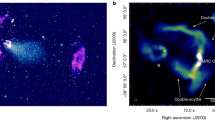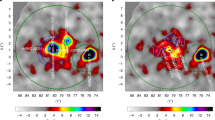Abstract
THE giant elliptical galaxy Cygnus A is regarded as the archetypal high-luminosity radio galaxy. These objects contain radio jets: an unknown energy source in the galactic nucleus generates two collimated outflows in opposite directions, which create radio hotspots where they interact with the surrounding intergalactic medium. Many radio galaxies are known to emit X-rays; in some cases these bave been shown to come from the central core region, and in others from an extended galactic halo. Here we report the detection of X-ray emission from the hotspots of Cygnus A, obtained with the High Resolution Imager of the Rosat satellite. We show that an explanation based on thermal bremsstrahlung from a hot gas is inconsistent with radio polarization data and that a synchrotron model would require a population of relativistic electrons distinct from that responsible for the radio emission. Inverse Compton scattering of radio photons by relativistic electrons in the hotspots is, however, able to account for the observed X-ray intensity. A model based on this latter mechanism allows us to calculate the average magnetic fìeld strength and the energy content of the relativistic electrons in the hotspots.
This is a preview of subscription content, access via your institution
Access options
Subscribe to this journal
Receive 51 print issues and online access
$199.00 per year
only $3.90 per issue
Buy this article
- Purchase on Springer Link
- Instant access to full article PDF
Prices may be subject to local taxes which are calculated during checkout
Similar content being viewed by others
References
Spinrad, H. & Stauffer, J. R. Mon. Not. R. astr. Soc. 200, 153–158 (1982).
Carilli, C. L., Dreher, J. W., Conner, S. & Perley, R. A. Astr. J. 98, 513–523 (1989).
Dreher, J. W., Carilli, C. L. & Perley, R. A. Astrophys. J. 316, 611–625 (1987).
Mannheim, K., Krulls, W. M. & Biermann, P. L. Astr. Astrophys. 251, 723–731 (1991).
Pacholczyk, A. G. Radio Astrophysics (Freeman, San Francisco, 1970).
Band, D. L. & Grindlay, J. E. Astrophys. J. 298, 128–146 (1985).
Band, D. L. & Grindlay, J. E. Astrophys. J. 308, 576–591 (1986).
Carilli, C. L., Perley, R. A., Dreher, J. W. & Leahy, J. P. Astrophys. J. 383, 554–573 (1991).
Harris, D. E., Perley, R. A. & Carilli, C. L. in Proc. Astronomical Data Analysis and Software Systems—III (eds Crabtree, D. R., Hanisch, R. J. & Barnes, J.) (Astr. Soc. Pacif. Conf. Ser., San Francisco, in the press).
Carilli, C. L. Dreher, J. W. & Perley, R. A. in Radio Hotspots in Extragalactic Radio Sources (eds Meisenheimer, K. & Roser, H. J.) 51–60 (Springer, Heidelberg, 1989).
van den Bergh, S. Astrophys. J. 210, L63–L64 (1976).
Yee, H. K. C. & Oke, J. B. Astrophys. J. 226, 753–769 (1978).
Author information
Authors and Affiliations
Rights and permissions
About this article
Cite this article
Harris, D., Carilli, C. & Perley, R. X-ray emission from the radio hotspots of Cygnus A. Nature 367, 713–716 (1994). https://doi.org/10.1038/367713a0
Received:
Accepted:
Issue Date:
DOI: https://doi.org/10.1038/367713a0
This article is cited by
-
Disks and Jets
Space Science Reviews (2015)
-
Magnetic Fields in Astrophysical Jets: From Launch to Termination
Space Science Reviews (2012)
-
The X-ray jets of active galaxies
The Astronomy and Astrophysics Review (2009)
Comments
By submitting a comment you agree to abide by our Terms and Community Guidelines. If you find something abusive or that does not comply with our terms or guidelines please flag it as inappropriate.



